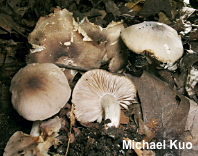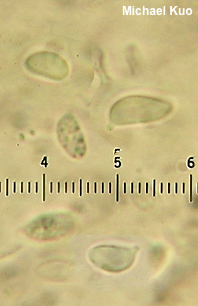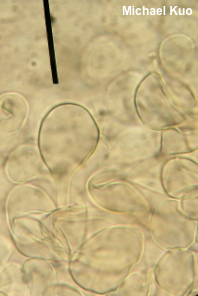| Major Groups > Gilled Mushrooms > Pale-Spored > Tricholoma > Dermoloma cuneifolium |

|
Dermoloma cuneifolium [ Basidiomycota > Agaricales > Tricholomataceae > Dermoloma . . . ] by Michael Kuo I thought this was yet another boring, mealy-smelling, gray Tricholoma when I collected it seven years ago. I took some lousy, half-hearted photos, wrote a minimal description, and preserved it, all the while wondering why I was even bothering. So when I finally studied the thing under the microscope the other day it was quite a surprise when the cap surface was composed of lined-up inflated cells (making it "hymeniform" in Mycologese) rather than repent, tubular cells (a "cutis"), since the latter is common to all tricholomas. And it took me a while to figure out what the collection represented, if not Tricholoma, because Dermoloma is basically absent from North American literature. A few collections have been made on our continent, according to online herbarium records, but not many, and the genus is not included in our field guides. So I consulted European literature, since dermolomas appear to be common there. So here you go, North America: Dermoloma cuneifolium is here! Let's see if we can figure out its distribution. Look for a smallish, "tricholomatoid" mushroom (meaning: stature like a tricholoma) with notched white gills, a white spore print, mealy odor and a very bald cap surface that is not radially fibrillose or finely scaly. Description: Ecology: Possibly saprobic, since it is sometimes found in grasslands without trees nearby; growing gregariously in grassy areas or in hardwood forests; summer and fall; common in Europe; North American distribution uncertain (reported primarily from the Midwest). The illustrated and described collection is from Illinois. Cap: 3–5 cm across; at first convex, becoming broadly convex to nearly flat; dry; bald; gray-brown, with a slightly darker center. Gills: Attached to the stem by a notch; close or nearly distant; short-gills frequent; white. Stem: 3–5 cm long; 0.5–1 cm thick; equal; bald; dry; white. Flesh: White; unchanging when sliced. Odor and Taste: Mealy. Spore Print: White. Microscopic Features: Spores 4.5–7 x 2.5–4 µm; long-ellipsoid; smooth; hyaline in KOH; inamyloid. Lamellar trama parallel. Basidia 4-sterigmate. Hymenial cystidia not found. Pileipellis hymeniform; terminal elements pyriform, 10–25 µm across, smooth, hyaline in KOH. Clamp connections present. REFERENCES: (Fries, 18181) Singer ex Bon, 1986. (Moser, 1983; Breitenbach & Kränzlin, 1991; Arnolds, 1992; Arnolds, 1995; Nonis, 2007; Buczacki et al., 2012; Vesterholt, 2012; Iglesias, 2019.) Herb. Kuo 10101201. This site contains no information about the edibility or toxicity of mushrooms. |
© MushroomExpert.Com |
|
Cite this page as: Kuo, M. (2019, November). Dermoloma cuneifolium. Retrieved from the MushroomExpert.Com Web site: http://www.mushroomexpert.com/dermoloma_cuneifolium.html |



